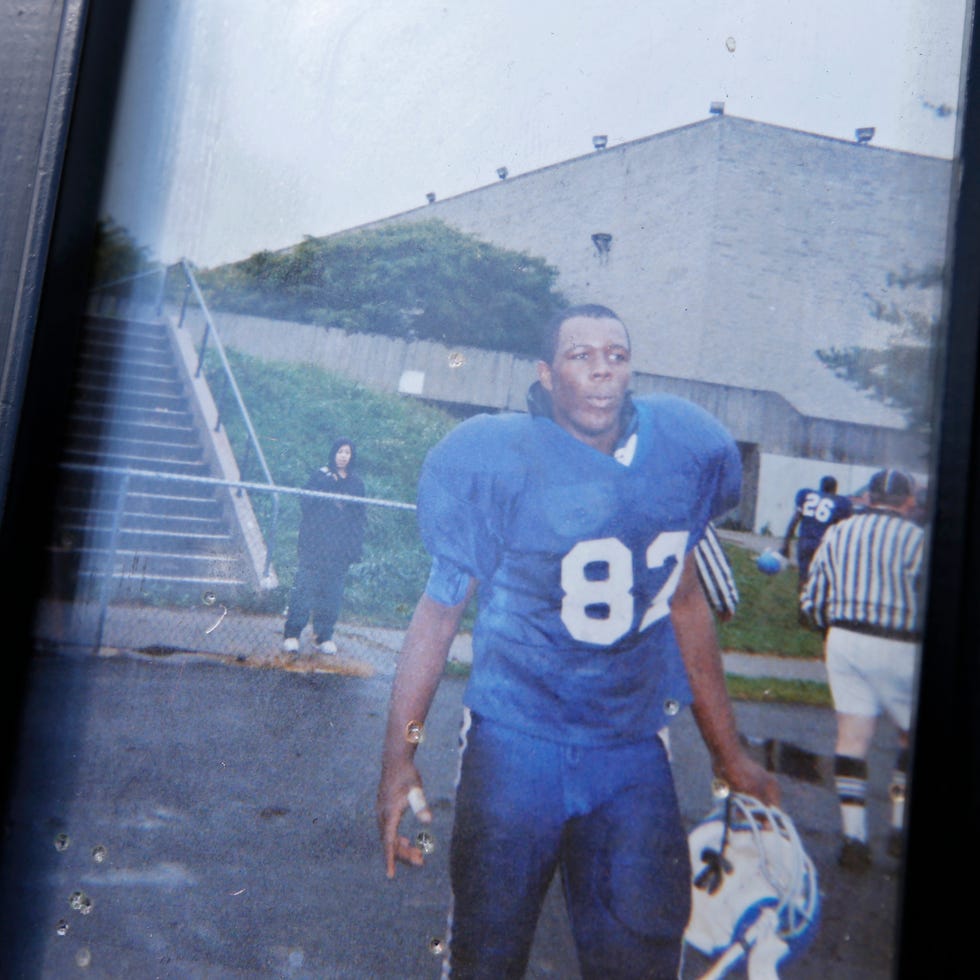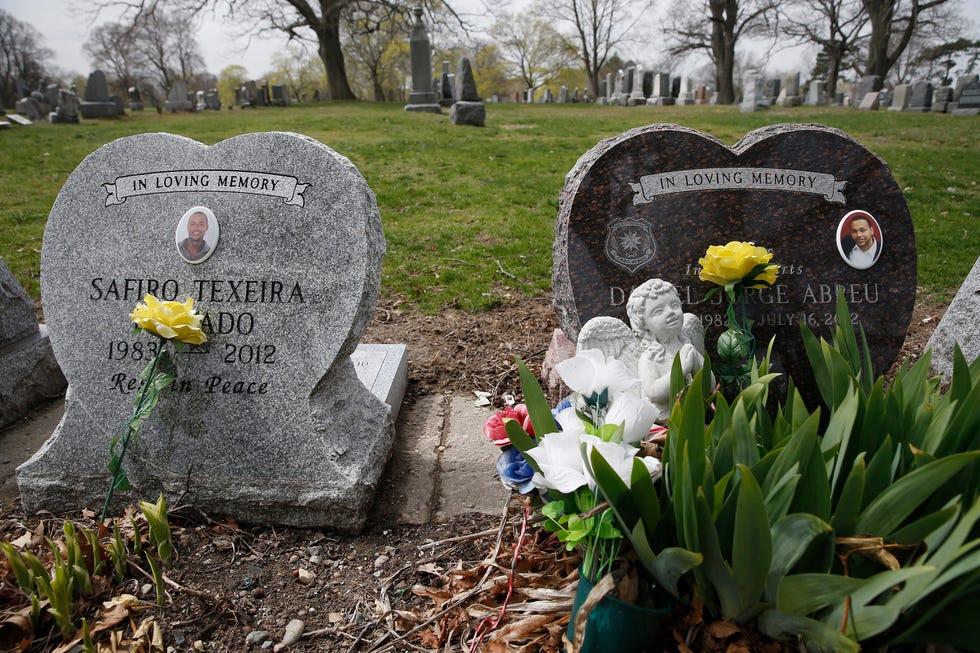
The story of Aaron Hernandez was both tragic and bizarre. He’d fulfilled a dream held by millions, achieving football superstardom, a multimillion dollar contract, a trip to the Super Bowl with the New England Patriots. And yet it all collapsed, amid horrifying evidence that implicated him in multiple murders. Netflix’s latest true crime documentary event, the three-part Killer Inside: The Mind of Aaron Hernandez, offers a gripping and detailed examination of the case. So here’s what you need to know.
Who was Aaron Hernandez?
Aaron Hernandez was born in Bristol, Connecticut in 1989. His father, Dennis Hernandez, was a custodian and his mother, Terri, was an administrative assistant. Both worked in local public schools.
His father had been a star athlete at Bristol Central High School growing up, and the family was respected in the football-loving town. But Hernandez’s home life was reportedly chaotic. Both his parents were arrested at points during his childhood—his mother for allegedly working in a bookkeeping operation, and his father for attempting to buy cocaine.
Dennis Hernandez was an abusive presence who beat both Aaron and his brother, DJ, as well as their mother. DJ later told The Boston Globe that his brother had been molested as a child.
Growing up in a home that the Globe described as “deeply homophobic,” Hernandez also reportedly struggled with his sexuality, and kept a relationship with a friend and teammate a closely-guarded secret. “‘F*ggot’ was used all the time in our house,” Hernandez’s brother told the newspaper. “All the time. Standing. Talking. Acting. Looking. It was the furthest thing my father wanted you to even look like in our household. This was not acceptable to him.”
Hernandez was Bristol Central’s star athlete, excelling in track, football, and basketball. He initially planned on following DJ to the University of Connecticut, where he played football football, but broke a verbal commitment to the school and decided to join the University of Florida Gators in Gainesville, alongside their star quarterback, Tim Tebow.
Hernandez’s father died from complications of a routine surgery while he was still in high school, a loss that, despite his dad’s abuse, his Gators coach Urban Meyer would describe as having decimated him. He entered college still grieving at just 17-years-old, and quickly began getting into trouble.
In a fight over a bar tab, just four months into his time in Florida, Hernandez reportedly burst a bar manager’s ear drum with a sucker punch. Police noted that after “working on an agreement” with the university, the victim did not want to pursue charges.
Later, a witness described a man fitting Hernandez’s description as the culprit in a double shooting that left two men injured after a night of clubbing, and the young athlete was questioned about the crime. But others at the scene described a shooter that didn’t resembleHernandez, and no one was ever charged for the crime.
Despite his off-field troubles, Hernandez excelled as a college athlete. The Gators won the championship his sophomore year, and he won the John Mackey Award for best college tight end in 2009. But Meyer reportedly let it be known that Hernandez wouldn’t be allowed to return to the team for his senior year, so at just 20 years old, he entered the NFL draft. Though one of the most promising athlete’s in that year’s draft, he wasn’t selected until the fourth round due to his troubled history and poor performance on personality tests, one of which noted that he was “not well-adjusted emotionally.”
Still, in 2010 he was drafted by the New England Patriots. The team made it to the Super Bowl in 2012, and though the New York Giants won the championship, Hernandez scored a touchdown during the game. That year, he signed a five-year, $40 million dollar contract extension with Patriots, and received an unprecedented $12.5 million dollar bonus.
Despite these successes, Hernandez continued to behave erratically and violently—in February 2013, he allegedly shot his friend and companion Alexander Bradley in the face and dumped him in a Miami parking lot. Bradley, a career criminal, lost an eye, but did not tell police who shot him. Instead, he later filed a civil suit against the athlete, which was settled in 2016.
Who was Odin Lloyd?
By 2013, Hernandez was engaged to be married to his high school sweetheart, Shayanna Jenkins, and the two had a daughter, Avielle. Shayanna’s sister, Shaneah, dated a 27-year-old Saint Crucian-American, the landscaper and semi-professional football player Odin Lloyd, and the two men became friends.
On June 17th, 2013, Lloyd’s body was found one mile from Hernandez’s North Attleborough home. He’d been shot multiple times, and police quickly zeroed in on Hernandez, Lloyd’s only known friend in the area. Evidence connecting Hernandez to the crime scene abounded. DNA taken from a blunt found near the body matched the famed football player, and a shell casing found inside a car rented in Hernandez’s name matched the bullets that had killed Lloyd.
Hernandez was arrested on June 26th, and was released by the Patriots the same day.
The investigation into Lloyd’s murder lead police to the home of Hernandez’ cousin. There, they found a Toyota 4-Runner, a vehicle that had been wanted in connection with the 2012 Boston double murder of Daniel Jorge Correia de Abreu and Safiro Teixeria Furtado. Bradley claimed that one of the men accidentally bumped into Hernandez in a nightclub, causing the right end to spill his drink and sending him into a rage. According to Bradley, he and Hernandez followed the men’s vehicle after they left the club, and when they pulled alongside it, Hernandez sprayed bullets into the car.
No certain motive for Lloyd’s murder was discovered, but Hernandez was convicted for the crime on April 15th, 2015, and received a sentence of life in prison. Two friends who were with him on the night of the killing, Carlos Ortiz and Ernest Wallace, were convicted of being accessories to the crime.
In 2017, Hernandez was tried for the Boston double murder, but amid his accusation that it was actually Bradley who shot the two men, was acquitted of the crime.
How did Aaron Hernandez die?
On April 19th, 2017, just five days after his acquittal for the murders of de Abreu and Furtado, Hernandez hanged himself in his cell at the Souza-Baranowski Correctional Center. The families of the three men Hernandez was accused of murdering all filed civil suits against him, and eventually reached settlements with his estate.
The Boston University CTE Center, which has examined the brains of dozens of former NFL players for chronic traumatic encephalopathy, a degenerative illness caused by repeated head injuries that can result in behavioral problems and dementia, studied Hernandez’s brain after his death. The lab reported that the 27-year-old had a severe case of the disorder.
“Especially in the frontal lobes, which are very important for decision-making, judgment, and cognition, we could see damage to the inner chambers of the brain,” BU CTE Center director Ann McKee said in 2017. “This would be the first case we’ve ever seen of that kind of damage in such a young individual.”
 Print
Print





